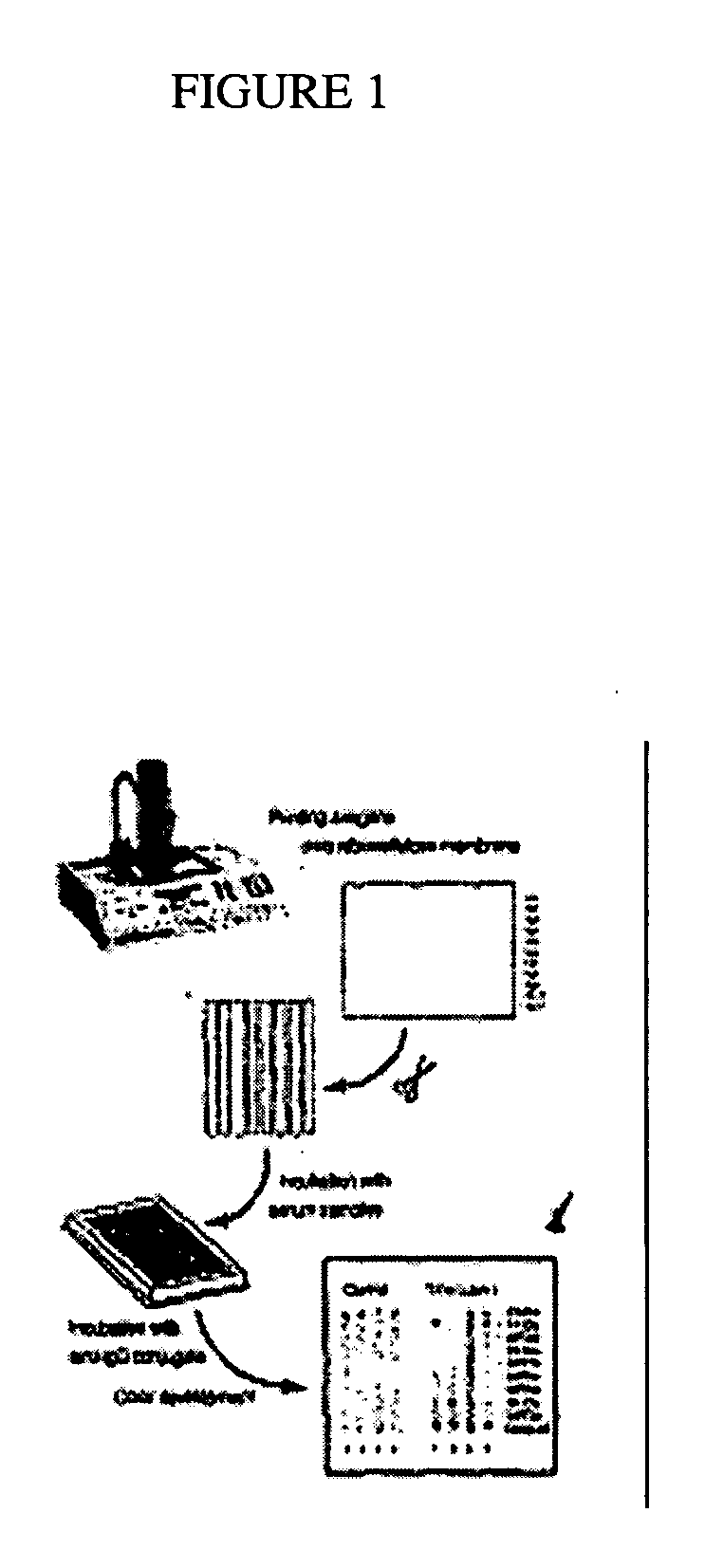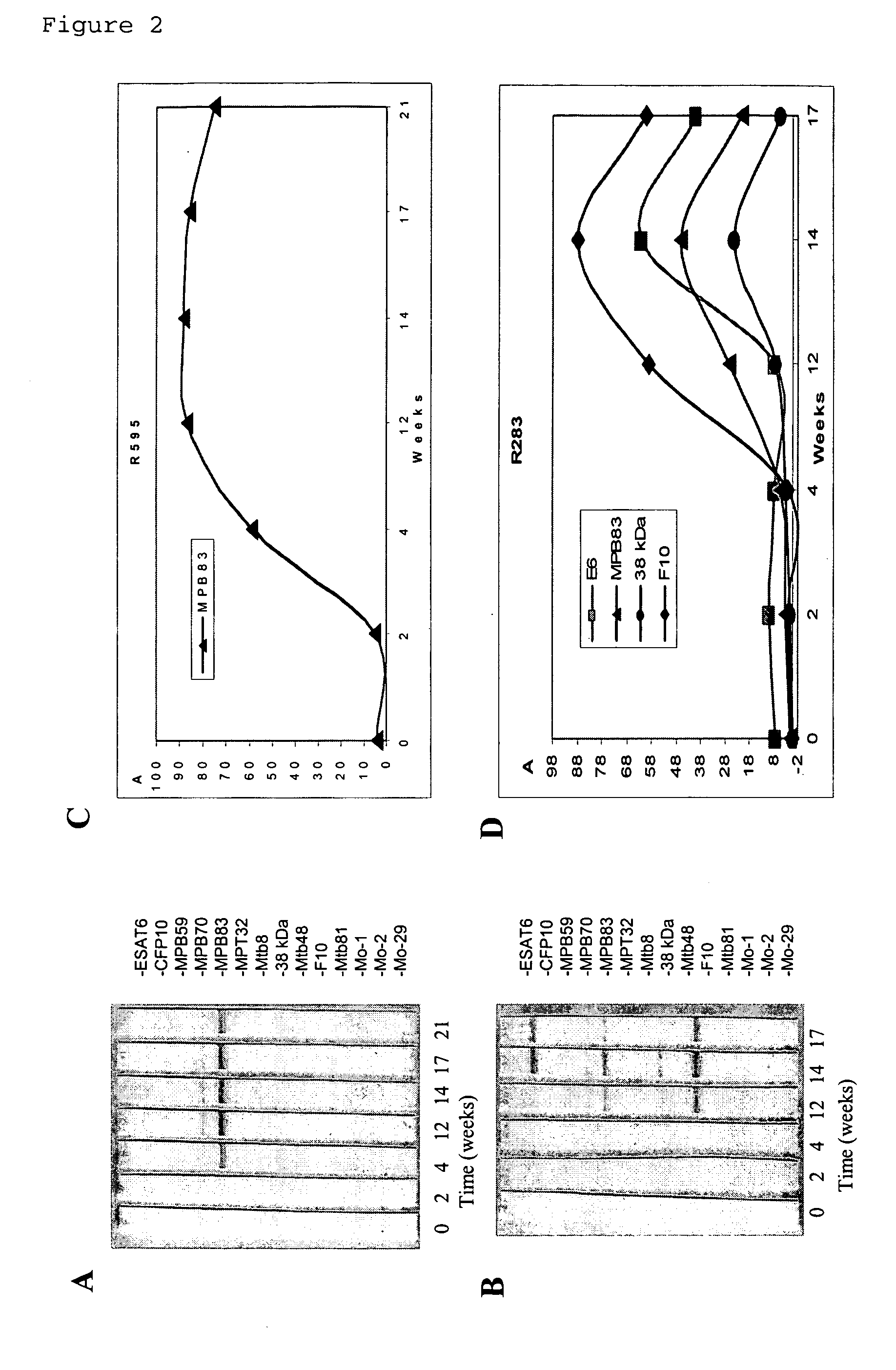Assay for detecting tuberculosis in nonhuman primates
a technology for detecting tuberculosis and nonhuman primates, which is applied in the field of methods and compositions for detecting the presence of mycobacterial organisms, can solve the problems of limited methods, insensitive, inconvenient use, and significant problems for nonhuman primate populations and humans, and achieves the effect of convenient use and sensitiveness
- Summary
- Abstract
- Description
- Claims
- Application Information
AI Technical Summary
Benefits of technology
Problems solved by technology
Method used
Image
Examples
example 1
Selection of Antigens
[0072] Mycobacterial antigens of the present invention were selected using Multi-Antigen Print ImmunoAssay (MAPIA) as described in Lyashchenko et al., 2000. Briefly, antigens were immobilized on a nitrocellulose membrane (Schleicher & Schuell BioScience, Inc. USA, Keene, N.H.) at a protein concentration of 0.05 mg / ml by using a semiautomated airbrush printing device (Linomat IV; Camag Scientific, Inc., Wilmington, Del.). The membrane was cut perpendicular to the antigen bands into 4-mm-wide strips. The strips were blocked for 1 h with 1% nonfat skim milk in PBS, pH 7.2, with 0.05% Tween 20 and then incubated for 1 h with serum samples diluted 1:50 in blocking solution. After being washed, the strips were incubated for 1 h with alkaline phosphatase-conjugated anti-human immunoglobulin G antibody (Sigma Chemical Co., St. Louis, Missoury) diluted 1:5,000 in blocking solution, followed by another washing step. Bound antibodies were visualized with 5-bromo-4-chloro-...
example 2
Serological Responses in Monkey Tuberculosis
[0073] In MAPIA, 14 infected monkeys produced IgG antibodies of variable levels and starting at various time-points post-infection. FIG. 2. As shown in Table 2-4 below, antigen recognition patterns varied significantly from animal to animal. Three proteins, ESAT-6, MPB83, and TBF10 were most often recognized by post-infection serum samples.
TABLE 2Antigen recognition patterns in M. tuberculosisinfectionAnimal #Antigen056209283304590595653727729814847855861867ESAT6CFP10Mo-1Mo-2Mo-29Mtb838 kDaMtb48MPB70MPB83MPB59MPT32Mtb81TBF10TBF6Any antigen
Antigen recognition is indicated by grey cells.
[0074]
TABLE 3Antigens predominantly recognized in experimental TB*
*Antigens eliciting earliest antibody are shown in gray. Results are shown as negative (−) or Positive (+, weak; ++, moderate; +++, strong).
[0075]
TABLE 4Antigen recognition by serum IgG in monkey TBAntibodyreactorsAntigenNumber%ESAT-61071CFP10750Mo-100Mo-200Mo-29321Mtb821416 kDa64338 kDa17...
example 3
Specific Antigen Mixtures in Protein a Lateral Flow Assay
[0076] An antigen mixture consisting of the three selected proteins was formulated and evaluated in the lateral flow format. Printing conditions were optimized for ESAT-6, MPB83, and TBF10 separately by spraying each antigen at various concentrations onto the membrane, both singly and in mixtures, and selecting one concentration for each antigen that resulted in the strongest discrimination between selected TB positive and negative serum samples. A mixture of the antigens was then printed onto nitrocellulose membrane at concentration of 1 mg / ml. Protein A was printed onto the membrane as an additional line to produce the control line. Protein A was also conjugated to colloidal gold particles following routine procedures known in the art and was used as the nonhuman primate IgG antibody-detecting molecule in the lateral flow immunoassay. Test strips were laminated, such that a conjugate pad was placed between the sample pad an...
PUM
| Property | Measurement | Unit |
|---|---|---|
| pore sizes | aaaaa | aaaaa |
| pore sizes | aaaaa | aaaaa |
| pore sizes | aaaaa | aaaaa |
Abstract
Description
Claims
Application Information
 Login to View More
Login to View More - R&D
- Intellectual Property
- Life Sciences
- Materials
- Tech Scout
- Unparalleled Data Quality
- Higher Quality Content
- 60% Fewer Hallucinations
Browse by: Latest US Patents, China's latest patents, Technical Efficacy Thesaurus, Application Domain, Technology Topic, Popular Technical Reports.
© 2025 PatSnap. All rights reserved.Legal|Privacy policy|Modern Slavery Act Transparency Statement|Sitemap|About US| Contact US: help@patsnap.com



